MONROVIA, Calif. — Most mornings, like clockwork, you could find Art Ballard pumping iron.
At least five days a week, he drove to Foothill Gym, where he beat on the punching bag, rode a stationary bike and worked his abs. After he joined the gym five years ago, he dropped 20 pounds, improved his balance and made friends.
At 91, he’s still spry and doesn’t take any medication other than an occasional Tylenol for aches and pains.
“Doctors love me,” he said.
But when California enacted a statewide stay-at-home order in mid-March, his near-daily physical exercise and social interactions abruptly ended.
Ballard’s health started to deteriorate: His back hurt, his legs cramped and he started becoming short of breath. As happens too often with older people, he also started to feel isolated and depressed.
“I was deeply concerned for myself because I didn’t have an exercise routine at home,” he said.

Art Ballard is proud that he doesn’t have to rely on several medications at his age. He takes only Tylenol as needed for aches and pains.(Heidi de Marco/KHN)

Art Ballard worked out at Foothill Gym a few weeks before it was officially open to the public. “I’m feeling so good,” he says. “I snapped back.”(Heidi de Marco/KHN)
The University of Southern California’s Dornsife Center for Economic and Social Research conducted an analysis in late March, as the coronavirus established a foothold in the U.S., that found that older adults over 60 who lived alone were more likely to report feeling anxious or depressed than those living with companions.
The combination of the pandemic and nationwide lockdown orders put this already vulnerable population at greater risk, said Julie Zissimopoulos, co-director of the aging and cognition program at USC’s Leonard D. Schaeffer Center for Health Policy & Economics. Social distancing measures have weakened the support systems that older people who live alone depend on for basic activities, such as help with grocery shopping and transportation to doctor appointments.
“There’s a huge, disproportionate impact on older adults with this virus and the health outcomes,” said Lisa Marsh Ryerson, president of AARP Foundation. “During this shutdown, we’ve had growing public health and community acknowledgement of how serious it can be to sever the ties with our network.”
Ballard, a retired jeweler, lives alone in a one-bedroom condo in Monrovia, a city of about 36,000 people about 20 miles northeast of downtown Los Angeles. He lost his wife of more than 50 years, Dorothy, to Alzheimer’s disease in 2015. Since then, he has embraced his solitude and reveled in his newfound bachelorhood. He enjoys cooking and trying out recipes, listening to 1950s music and watching YouTube videos about World War II.
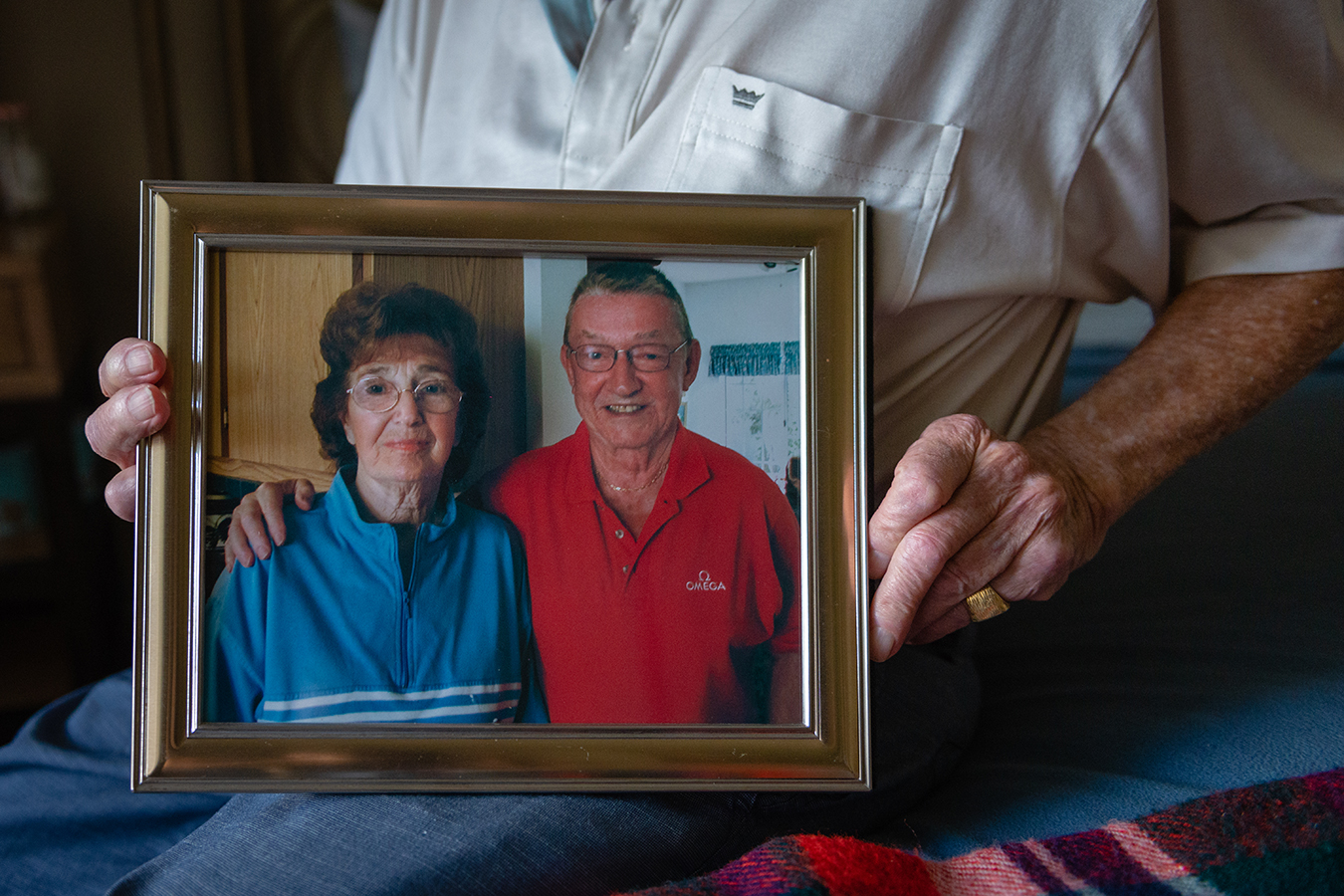
Ballard holds a photograph of himself and his wife, Dorothy. She died from complications of Alzheimer’s disease almost five years ago. (Heidi de Marco/KHN)
He has a girlfriend he met online — a retired greyhound trainer who lives in Arkansas. They haven’t yet met in person.
Ballard felt he could handle the isolation of the lockdown order. He didn’t have visitors during quarantine, but his son, Dan Ballard, checked on him by phone weekly.
In the beginning, Ballard tried to keep busy. He did his shopping early in the morning and took strolls around his neighborhood. But after a couple of months of not visiting the gym, Ballard began feeling sad and frustrated, and his health started to slide. He relied more on his walker and sometimes struggled to breathe.
“My girlfriend was concerned with how I was thinking,” said Ballard, who speaks to her on the phone several times a day.
For Ballard, a self-proclaimed gym addict, Foothill Gym was a second home. Just as in the 1980s sitcom “Cheers,” it’s a place where everybody knows his name. Not going to the “club,” as he calls it, was taking a toll on his mental and physical health, so he decided to visit Brian Whelan, the owner of the small, family-run gym, in late May.
“He comes in, out of breath, with a walker,” Whelan recalled. “He couldn’t hold his head up straight and it took him five minutes to catch his breath.”
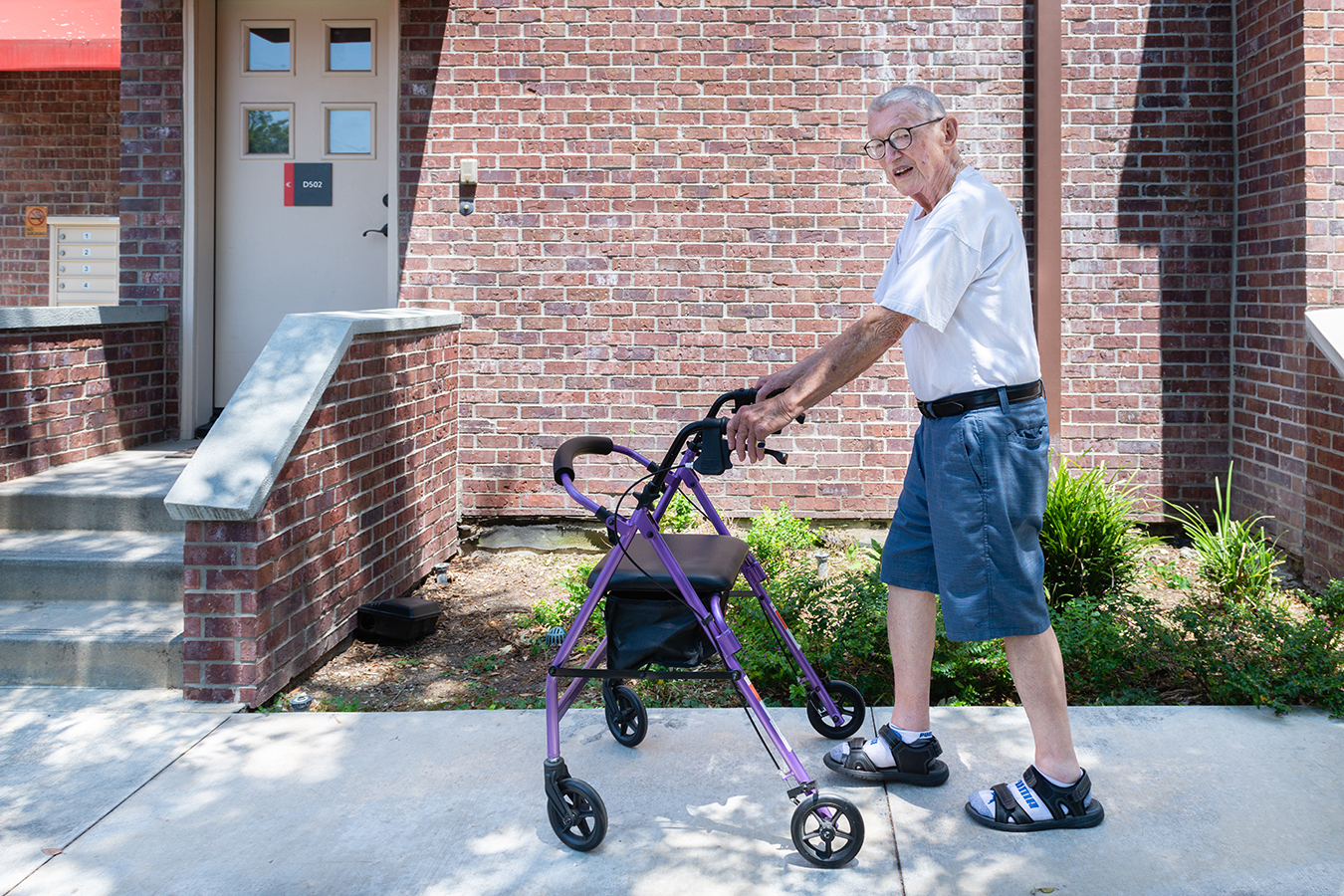
During the lockdown, Ballard started having difficulty keeping his balance. His solution was to walk around his neighborhood with a walker. (Heidi de Marco/KHN)

Art Ballard takes a break between sets to chat with Foothill Gym owner Brian Whelan on June 13. For Ballard, the benefits of the gym are twofold. “It’s the health factor and the social aspect,” he says. “Everybody there is so positive. It makes my day worthwhile.”(Heidi de Marco/KHN)
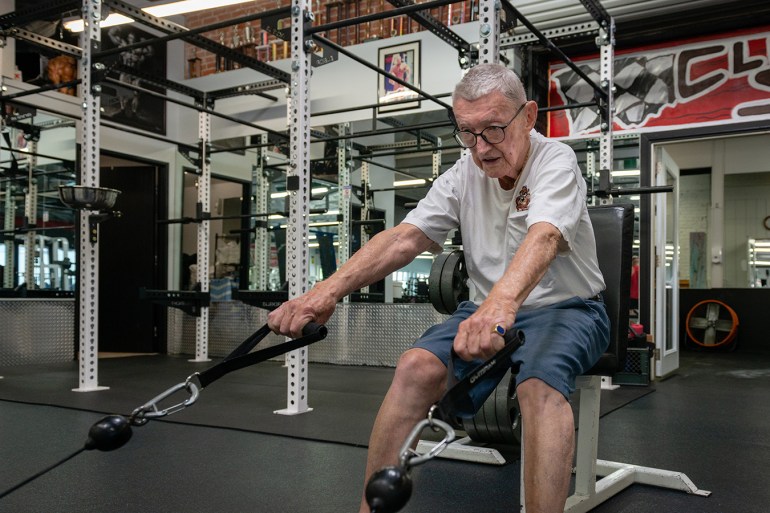
Art Ballard performs seated cable pulls during his total body workout at the gym. “I try to get my heart rate up to 140,” Ballard says.(Heidi de Marco/KHN)
Whelan felt sad and angry. “Everyone here was almost in tears because this vibrant man was gone,” he said. So Whelan broke the rules. He invited Ballard to visit the gym even before it officially reopened to the public.
“The gym business is more than physical health,” said Whelan. “It’s mental health.”
Ballard resumed his beloved routine the last week of May, with the gym mostly to himself.
“Every day for the past two months, I’ve been sad,” Ballard said on the first day back. “Today, I woke up and I was happy.”
Day after day, Ballard improved. “Now he comes in without a walker, head up straight, and the spark in his eyes is getting brighter,” Whelan said.
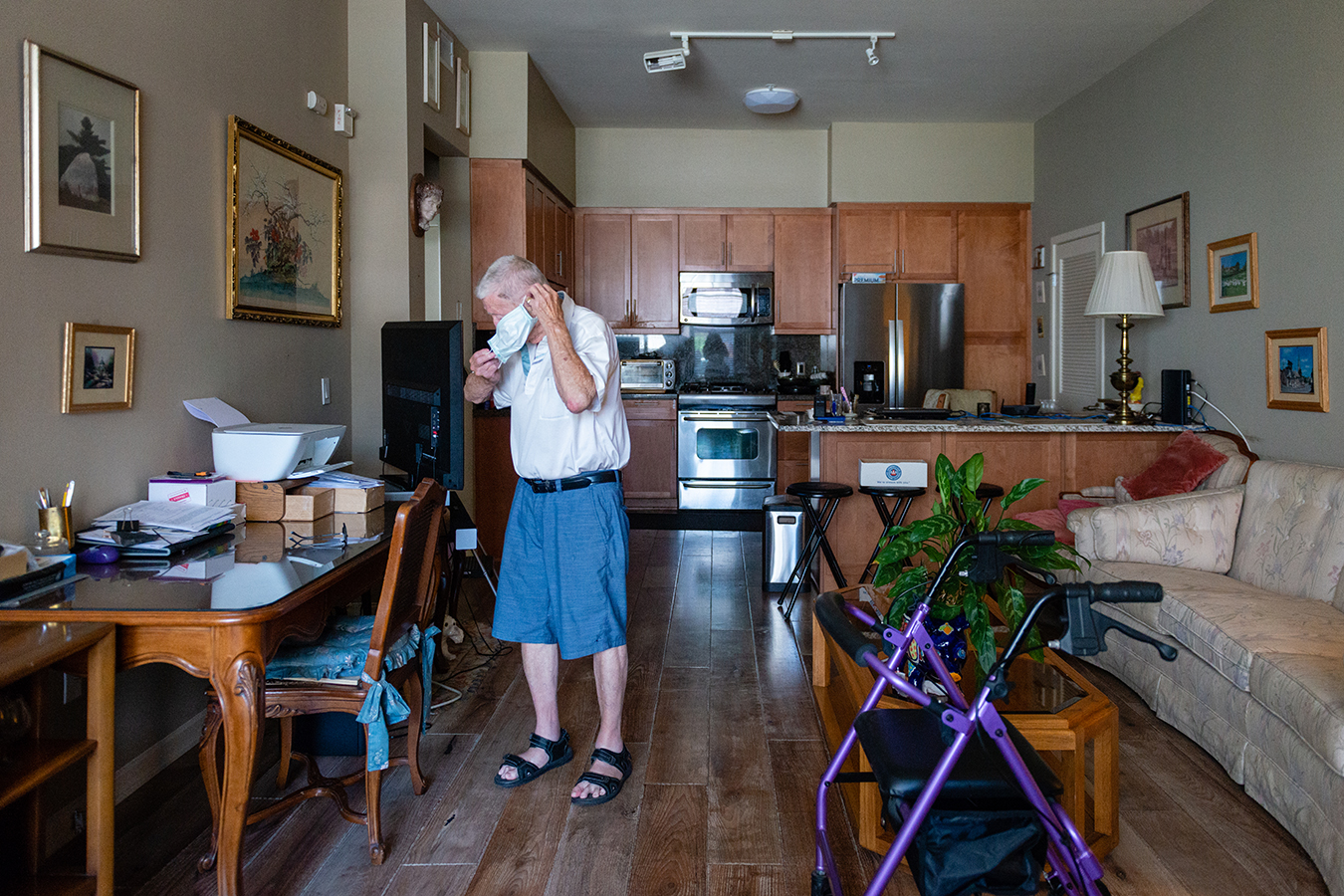
Ballard says it took him a while to get his hands on a mask. He wears it when he goes grocery shopping and to doctor appointments. (Heidi de Marco/KHN)
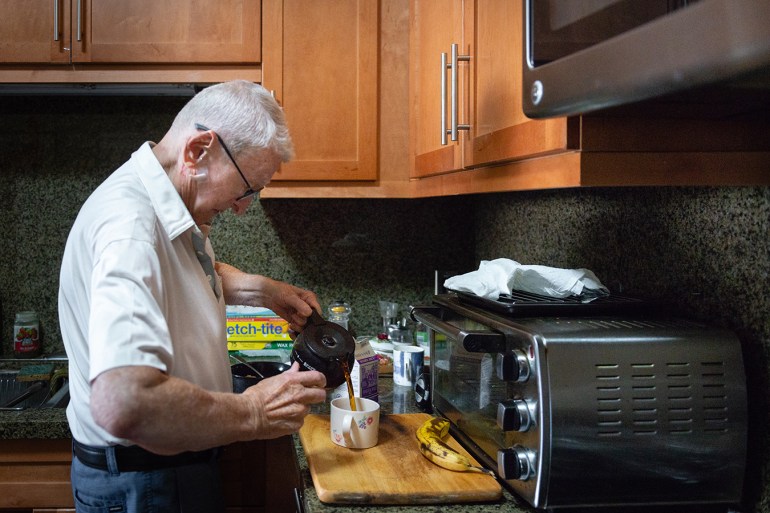
Art Ballard lives alone in a one-bedroom apartment. He’s self-sufficient and says he wants to live independently as long as possible. More than one-quarter of adults 65 and older live by themselves, according to 2018 U.S. Census Bureau statistics.(Heidi de Marco/KHN)
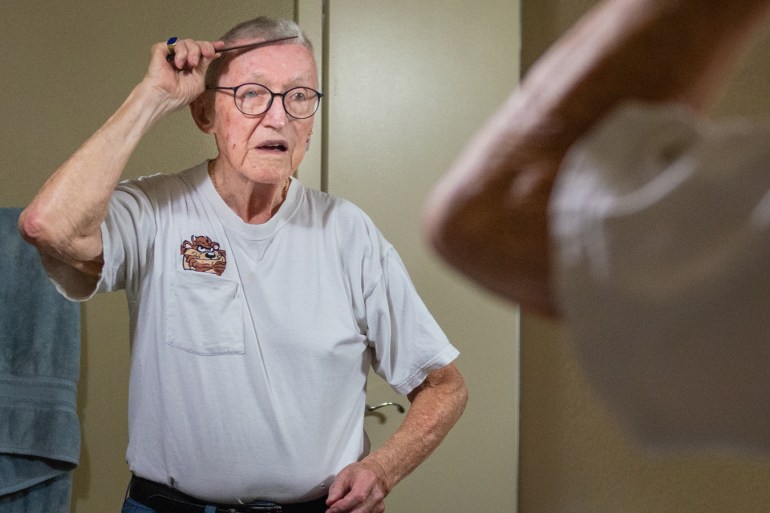
Art Ballard combs his freshly cut hair before heading to the gym. He has always had a crew cut, and the quarantine forced him, for the first time, to grow it out.(Heidi de Marco/KHN)
The gym reopened June 15. Despite the threat of COVID-19, Ballard is back to working out six days a week. Masks are required to enter the gym but can be removed when exercising.
Ballard isn’t worried. “I’m 100% comfortable,” he said. “I’ll wear a mask if they ask me to.”
Son Dan said he’s worried about his dad being around people, but realizes the benefits.
“It’s a scary balance. If he stops going to the gym and can’t see anybody, I know he’s going to deteriorate,” he said. “At the end of the day, it’s a quality-of-life decision that’s his to make.”
Ballard believes not being able to socialize was a bigger threat to his health than the risk of contracting the coronavirus.
“I found out how important my routine and exercise is,” said Ballard. “It’s given me back my life. And it’s only going to get better.”
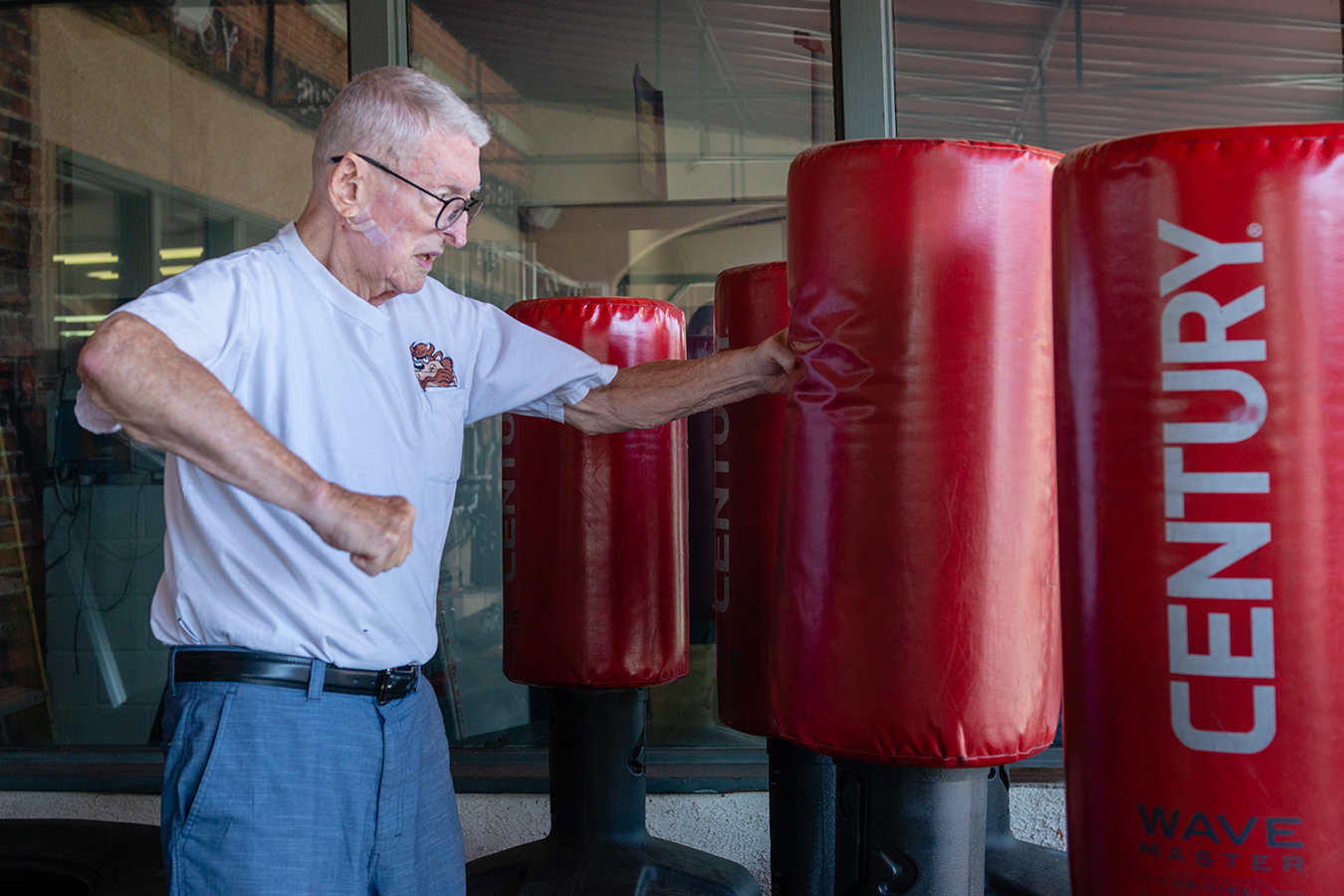
Ballard always ends his gym session punching the heavy bag at least 60 times in a row, he says. “The most important thing to do is to shake those bones up, especially when you’re old,” he says. (Heidi de Marco/KHN)
This KHN story first published on California Healthline, a service of the California Health Care Foundation.
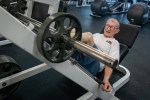
Back home in Bloomfield Hills, Michigan, Richard and Denise Victor would get to see their four grandchildren almost every day. One set of kids lives around the block; the others are half an hour away, all close enough for frequent visits and sleepovers.
“With the younger ones, we have a routine of stories when they spend the night,” Richard Victor said.
But when the coronavirus hit, the couple were at their vacation home in Florida and, suddenly, it wasn’t safe to leave. They’ve been sheltering there for three months, missing the grandkids, struggling with an absence that FaceTime just can’t fill.
“It’s very, very difficult,” said Victor, a 70-year-old lawyer and founder of the nonprofit Grandparents Rights Organization. “You have to try your best because we don’t know when this will be over with.”
Of all the hardships imposed by the coronavirus pandemic, few are as poignant as the reshaping of relationships between children and the grandparents who love them.
Across America, where more than 70 million people are grandparents, efforts to prevent infection in older people, who are most at risk of serious COVID-19 illness, have meant self-imposed exile for many. At the opposite extreme, some grandparents have taken over daily child care duties to help adult children with no choice but to work.
“All the grandparents in the country are aching,” said Madonna Harrington Meyer, a sociology professor at Syracuse University in New York. “Some are aching because they can’t see their grandchildren — and some are aching because they can’t get away from them.”
Both situations are the result of the fast-moving pandemic, which forced families to decide quickly whether to isolate with grandparents “inside the bubble or out,” Harrington Meyer said. Three months later, many are still grappling with those decisions — and worrying about an uncertain future.
“I think we all have the exact same set of issues,” said Harrington Meyer, author of the 2014 book “Grandmothers at Work: Juggling Families and Jobs.” “What will August bring? All of us need to be prepared for this to be fluctuating.”
For grandparents separated from their grandchildren, the risks posed by gathering in person haven’t changed, said Dr. Krutika Kuppalli, an affiliated clinical assistant professor of medicine in the infectious diseases division at Stanford University. Rates of serious illness and death caused by COVID-19 remain much higher in older people than the young, and children can easily spread the disease.
“It’s hard to know if a child has been exposed or whether they have asymptomatic infection,” Kuppalli said. “I would definitely recommend staying away or definitely continuing to wear masks and perform good hand hygiene.”
At the same time, maintaining a connection with grandkids is important for the well-being of everyone, said Dr. Preeti Malani, chief health officer and professor of medicine at the University of Michigan in Ann Arbor.
“There’s an incredible health benefit to them to interact with their grandparents,” she said. “There’s nobody who loves children like their grandparents.”
In Highland Beach, Florida, Victor said he and wife Denise, who’s in her 60s, have relied heavily on Zoom, FaceTime and videos to stay connected to their grandchildren. Still, it’s been difficult. Since February, the two older boys, ages 10 and 13, have gotten taller and better at basketball. The baby has gone from crawling to walking. And their precocious 4-year-old grandson has paid close attention to the passing time.
“He let me know I’d been gone long enough that he’s not 4½ anymore. He’s 4¾,” Victor said. “We miss them all so much.”
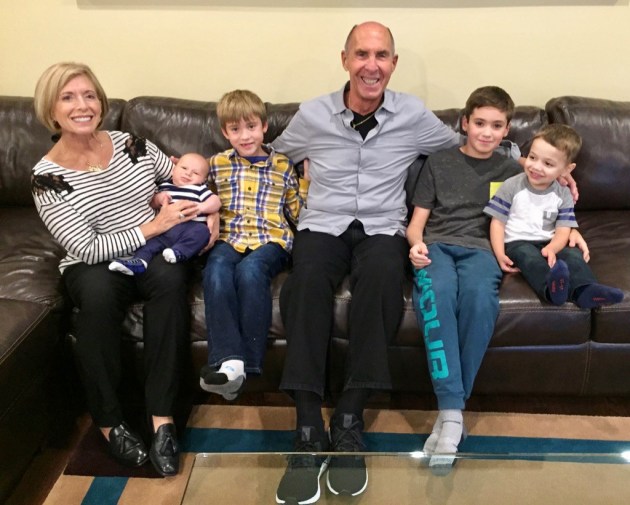
Richard and Denise Victor of Bloomfield Hills, Michigan, haven’t seen their grandkids since February. In happier times — before the coronavirus pandemic — they had regular visits with grandsons (from left) Daren Cosola, Stirling Victor, Davis Victor and Lucas Cosola.(Courtesy of the Victor family)
Some grandparents have calculated that the need to care for their families outweighs the fear of infection. Fran Layton, 73, a lawyer who lives in Berkeley, California, rushed to pick up her 2-year-old grandson in San Francisco in late March when his newborn sister arrived earlier than planned.
“My son called and said, ‘Mom, they’re going to induce. Can you get here?’ I did not hesitate,” Layton recalled.
She kept the toddler for a couple of days at that time. A month later, she started caring for him at her home a few days each week so his parents could juggle work and the new baby.
“He would take his naps in a stroller in the afternoon,” Layton said. “I walked the Berkeley Hills while he napped. It got me my exercise.”
Recently, Layton’s son and daughter-in-law decided to return to using their son’s nanny. Layton agreed with that decision, but also knew that widened the circle of infection risk. For now, she is choosing to stay away and doesn’t know when she’ll be together again with her grandson — or her new granddaughter.
“I was a mess when he left,” she said. “It’s sadness that we all feel forced apart with children and grandchildren.”
Some grandparents continue to see their grandchildren in person, finding ways to stay apart while still being together. “The outdoors is safer than the indoors, in general,” said Malani, the University of Michigan professor. “To me, a walk in a park, without a play structure, without other kids around, is OK.”
About 4% of grandparents live with their grandchildren, so staying away isn’t an option.
As of mid-May, Beth Kashner has joined that group. Her daughter’s family, including an 11-year-old granddaughter and 10-year-old grandson, relocated from Brooklyn to Kashner’s large Seattle home “while normal life is on hold,” or at least for the summer.
“They even brought their two cats,” said Kashner, 73. “I’m really happy that everyone will be part of the same safe community.”
Kashner already lived less than a mile from her four other grandchildren, who range in age from 3 to 10. For weeks, she saw them only from afar. Now, the whole family is gathering. It may be risky, but they’re taking pains to stay as safe as possible, she said.
“We did just go to the park wearing masks and trying to keep our distance,” she said.
For those who must be physically close to their grandchildren, there are ways to reduce the risk. Frequent hand-washing and sanitizing of high-touch surfaces is essential. Avoid contact with those outside the household. Masks and gloves can help.
And it’s not just the little ones. Adult grandchildren must consider carefully how to visit their grandparents, too. Malani recently took her family to visit her 97-year-old grandmother, Haridevi Malani, at home.
“It was a bit of a dilemma,” she said. “But I had a need to go visit her.”
Until a treatment or vaccine for the coronavirus is available, every interaction will be fraught with questions, she said. Going forward, families will need to weigh risks and benefits.
“We’re not going to have a situation where we can mitigate the risk to nothing,” Malani said. “It’s about how much risk you’re willing to take.”








